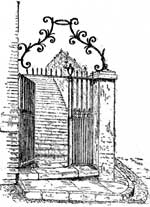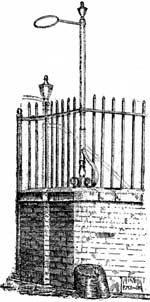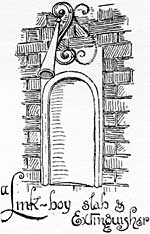Nottingham in the 18th century
ESPECIALLY WITH REFERENCE TO DOMESTIC ARCHITECTURE.
By MR. HARRY GILL, M.S.A.
“Houses, no less than men, carry their own past with them, and cannot hide from the discerning that subtle influence which is known as character.”1
“SOON after the Restoration, Nottingham put on quite a new Face, since which time many of the Inhabitants have taken to new Fronting their Houses after the newest Fashion, some with Parapet Walls. . . . A considerable Number of handsome Houses have of late been built by Wealthy Tradesmen, and more are daily Building.”2
A general statement like this is not peculiar to Nottingham. It might have been written concerning many other towns, for in the 18th century house building was in progess throughout the Kingdom.
I shall make no attempt at comparisons, however, neither shall I make more than passing reference to celebrated architects of the day. I propose to confine my attention to the buildings erected in our own town and district, and to record some of their most interesting features before the inevitable march of time has swept them away.
Before entering into details, let me give a brief general description of the town as it appeared two centuries ago.
The stone wall3 breast high—a relic of post-Conquest bitterness—still divided the great Market Place, extending from near the Butter Cross in front of the New Change to the Malt Cross4 opposite Sheep Lane. If one stood beneath the shade of the elm trees,5on Timber Hill (South Parade) and looked eastward, the tall Hen-cross6 could be seen near the top of Cuckstool Row (Poultry); while yet another cross7marked the place of the weekday market, at the junction of the Pavements and Fletcher Gate.
The market square, outside the line of the piazza,8 and the narrow streets and lanes leading thereto, were unpaved, or at most indifferently paved with “pebbles” obtained from the bed of the river, or with “boulders” from Kegworth. The “Pavements“9 were probably the earliest paved thoroughfares in the town, hence the name, and “The sole ancient Gate,10 lately still in being,” (Deering) is perpetuated in the name “Chapel Bar,”—the western entrance to the fortified town. There was no public lighting until 1762, when an Act of Parliament was obtained for lighting the Market Place, and all the principal streets. In all probability this only made “the darkness more visible,” for the globular lanterns, made of thick coarse glass, and the burners fed with whale-oil gave but a very small and irregular flare. Of all the public lamp-standards and brackets put up in compliance with this Act, only two remain, while not one specimen of a private lamp, on gateway or wall, is now to be found.

St Mary's churchyard, south-east.
Above the entrance gateway at the S.E. corner of St. Mary’s churchyard there is an ornamental wrought-iron bracket, having a ring in the centre to hold the lantern of an oil-lamp; and a standard in the palisade at the N.E. corner of the churchyard also has a supporting ring still intact; but the lanterns have been removed. These lanterns could not have been long in use, for this palisade was not set up until 1807; and, shortly afterwards, oil as an illuminant was superseded by coal-gas. On April 13th, 1819, ten gas-lamps were put up and lighted in Nottingham, when, “attracted by the novelty of the display, thousands of people crowded the streets and gazed with wonder and admiration on this beautiful triumph of science.”

St Mary's churchyard, north-east.
Previous to the introduction of oil-lamps, and indeed to some extent afterwards, travellers by night were fain to be content with the fitful light which emanated from the flaming torches, carried in the hands of their attendants. These torches, or “links” as they were called, were made of tow and pitch, and it was necessary, in order to keep them burning brightly, to trim them frequently by rubbing away the charred portions. It was deemed a wise precaution therefore, in houses of any pretension, to provide for this by having a shaped slab of stone built into the wall near the entrance door, upon which the waiting link-boys might rub their torches, without risk of smearing the brickwork. The surface of the slab being smooth and well covered with paint could easily be cleaned each day by the domestics. Extinguishers and link-rests were also provided either in conjunction with the slab or fixed to the iron palisade which invariably enclosed the steps leading up to the main entrance.

In many old towns—London, Bath, York, Edinboro’, &c.,—“link-boy-slabs” and “extinguishers” may be seen in position, but I have searched in vain for such a relic in Nottingham. They must have been fairly plentiful at one time, for there are numerous references in the Borough Records to “link-boys” who carried torches, to light the way for the “chairmen who carried passengers in sedan-chairs11—a mode of conveyance in vogue throughout the 18th century, and still lingering in use within the recollection of some of our older members.12
(1) Pam the Fiddler, by Halliwell Sutcliffe, p. 204.
(2) Deering’s History of Nottingham. Section I., p. 6. The compilation of this History was apparently completed before Badder and Peet’s map was published in 1744, although the History was not published until 1757.
(3) Pulled down 1711 and the Market Place paved.
(4) Re-built 1715, and finally destroyed 1804.
(5) Cut down 1791.
(6) Removed 1801.
(7) Removed 1804.
(8) No causeways until 1801.
(9) So called as early as 1494.
(10) Chapel Bar was pulled down in 1743.
(11) According to Deering Hackney sedans were used for hire to carry persons who are taken sick from home, and ancient ladies to church and visiting, as also young ones in rainy weather.”
(12) The last sedan to be seen in Nottingham streets was employed to convey Mrs. Hart from her house on St. Peter’s Church Walk to the High Pavement Chapel.
